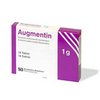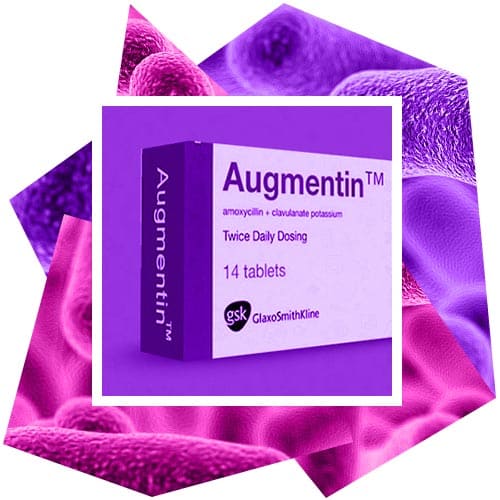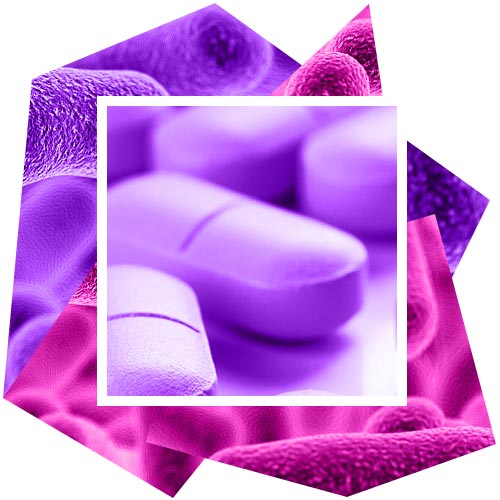Pharmacological Properties
Mechanism of Action
Amoxicillin is a semi-synthetic broad-spectrum antibiotic with activity against many gram-positive and gram-negative microorganisms. At the same time, amoxicillin is susceptible to destruction by beta-lactamases, and therefore the activity spectrum of amoxicillin does not extend to the microorganisms that produce these enzymes.
Clavulanic acid, a beta-lactamase inhibitor structurally related to penicillins, has the ability to inactivate a wide range of beta-lactamases found in penicillin and cephalosporin resistant microorganisms. Clavulanic acid is sufficiently effective against plasmid beta-lactamases, which most often cause bacterial resistance, and is less effective against type 1 chromosomal beta-lactamases.
The presence of clavulanic acid in the Augmentin preparation protects amoxicillin from destruction by enzymes - beta-lactamases, which allows expanding the antibacterial spectrum of amoxicillin. The following is the in vitro combination activity of amoxicillin with clavulanic acid.

Bacteria commonly susceptible to a combination of amoxicillin with clavulanic acid
Gram-positive aerobes
- Bacillus anthracis
- Enterococcus faecalis
- Gardnerella vaginalis
- Listeria monocytogenes
- Nocardia asteroides Streptococcus pneumoniae 1.2
- Streptococcus pyogenes1,2
- Streptococcus agalactiae 1.2
- Streptococcus group Viridans2
- Streptococcus spp. (other beta hemolytic streptococci) 1,2
- Staphylococcus aureus (methicillin sensitive) 1
- Staphylococcus saprophytics (methicillin sensitive)
- Coagulase-negative staphylococci (sensitive to methicillin)
Gram-positive anaerobes
- Clostridium spp.
- Peptococcus niger
- Peptostreptococcus magrtus
- Peptostreptococcus micros
- Peptostreptococcus spp.
Gram-negative aerobes
- Bordetella pertussis
- Haemophilus influenzae1
- Helicobacter pylori
- Moraxella catarrhal
- Neisseria gonorrhoeae
- Pasteurella multocida
- Vibrio cholerae
Gram-negative anaerobes
- Bacteroides fragilis
- Bacteroides spp.
- Capnocytophaga spp.
- Eikenella corrodens
- Fusobacterium nucleatum
- Fusobacterium spp.
- Porphyromonas spp.
- Prevotella spp.
Other
- Borrelia burgdorferi
- Leptospira icterohaemorrhagiae
- Treponema pallidum
Bacteria for which acquired resistance to a combination of amoxicillin with clavulanic acid is likely
Gram-negative aerobes
- Escherichia coli1
- Klebsiella oxytoca
- Klebsiella pneumoniae1
- Klebsiella spp.
- Proteus mirabilis
- Proteus vulgaris
- Proteus spp.
- Salmonella spp.
- Shigella spp.
Gram-positive aerobes
- Corynebacterium spp.
- Enterococcus faecium
Bacteria that are naturally resistant to the combination of amoxicillin with clavulanic acid
Gram-negative aerobes
- Acinetobacter spp.
- Citrobacter freundii
- Enterobacter spp.
- Hafnia alvei
- Legionella pneumophila
- Morganella morganii
- Providencia spp.
- Pseudomonas spp.
- Serratia spp.
- Stenotrophomonas maltophilia
- Yersinia enterocolitica
Other
- Chlamydia pneumoniae
- Chlamydia psittaci
- Chlamydia spp.
- Coxiella burnetii
- Mycoplasma spp.
- For these bacteria, the clinical efficacy of a combination of amoxicillin with clavulanic acid has been demonstrated in clinical studies.
- Strains of these types of bacteria do not produce beta-lactamases. Sensitivity with amoxicillin monotherapy suggests a similar sensitivity to the combination of amoxicillin with clavulanic acid.
Pharmacokinetics
Distribution
With the intravenous administration of a combination of amoxicillin with clavulanic acid, therapeutic concentrations of amoxicillin and clavulanic acid are found in various tissues and interstitial fluid (in the gallbladder, tissues of the abdominal cavity, skin, adipose and muscle tissues, synovial and peritoneal fluids, bile, and purulent discharge).
Amoxicillin and clavulanic acid have a weak degree of binding to plasma proteins. Studies have shown that about 13-20% of each of the components of the drug Augmentin binds to plasma proteins. In animal studies, no cumulation of the components of the drug Augmentin in any organ was found. Amoxicillin, like most penicillins, passes into breast milk. Traces of clavulanic acid may also be found in breast milk. With the exception of the possibility of developing diarrhea or candidiasis of the oral mucous membranes, no other negative effects of amoxicillin and clavulanic acid on the health of breast-fed infants are known. Animal reproductive studies have shown that amoxicillin and clavulanic acid cross the placental barrier. However, no adverse effects on the fetus were detected.
Metabolism
10-25% of the initial dose of amoxicillin is excreted by the kidneys in the form of an inactive metabolite (penicilloic acid). Clavulanic acid is extensively metabolized to 2,5-dihydro-4- (2-hydroxyethyl) -5-oxo-1H-pyrrole-3-carboxylic acid and 1-amino-4-hydroxy-butan-2-one and excreted by the kidneys, through the gastrointestinal tract (GIT), as well as with expired air in the form of carbon dioxide.
Breeding
Like other penicillins, amoxicillin is excreted mainly by the kidneys, while clavulanic acid is excreted by both the renal and extrarenal mechanisms. About 60-70% of amoxicillin and 40-65% of clavulanic acid are excreted by the kidneys unchanged in the first 6 hours after a single bolus injection of Augmentin. The simultaneous administration of probenecid slows down the excretion of amoxicillin, but does not slow down the renal excretion of clavulanic acid.
Indications for Use
The combination of amoxicillin with clavulanic acid is indicated for the treatment of bacterial infections of the following locations caused by microorganisms sensitive to the combination of amoxicillin with clavulanic acid:
- Upper respiratory tract infections (including infections of the LOP organs), such as recurrent tonsillitis, sinusitis, otitis media, commonly caused by Streptococcus pneumoniae, Haemophilus influenzae #, Moraxella catarrhalis #, and Streptococcus pyogenes.
- Lower respiratory tract infections, such as exacerbations of chronic bronchitis, lobar pneumonia, and bronchopneumonia, commonly caused by Streptococcus pneumoniae, Haemophilus influenzae #, and Moraxella catarrhalis #.
- Urogenital tract infections, such as cystitis; urethritis, pyelonephritis, female genital infections, usually caused by species of the Enterobacteriaceae # family (mainly Escherichia coli #), Staphylococcus saprophytics and species of the genus Enterococcus, as well as gonorrhea caused by Neisseria gonorrhoeae #.
- Skin and soft tissue infections commonly caused by Staphylococcus aureus. Streptococcus pyogenes and species of the genus Bacteroides #.
- Infections of bones and joints, for example, osteomyelitis, usually caused by Staphylococcus aureus #, if necessary, prolonged therapy is possible.
- Other mixed infections (e.g., septic abortion, postpartum sepsis, intra-abdominal sepsis, sepsis, peritonitis, postoperative infections) as part of step therapy.
- The drug Augmentin in a dosage of 1000 mg + 200 mg is also indicated for the prevention of postoperative infections, during surgical interventions on the gastrointestinal tract, pelvic organs, head and neck, heart, kidneys, biliary tract, as well as implantation of artificial joints.
Some representatives of this kind of microorganism produce beta-lactamase, which makes them insensitive to amoxicillin.
Infections caused by microorganisms sensitive to amoxicillin can be treated with Augmentin, since amoxicillin is one of its active substances. Augmentin is also indicated for the treatment of mixed infections caused by microorganisms sensitive to amoxicillin, as well as microorganisms producing beta-lactamases, sensitive to the combination of amoxicillin with clavulanic acid.
The sensitivity of bacteria to the combination of amoxicillin with clavulanic acid varies depending on the region and over time. Where possible, local sensitivity data should be taken into account. If necessary, microbiological samples should be collected and analyzed for bacteriological sensitivity.
Contraindications for Use
- hypersensitivity to amoxicillin, clavulanic acid, other components of the drug; a history of beta-lactam antibiotics (e.g., penicillins, cephalosporins);
- previous episodes of jaundice or impaired liver function when using a combination of amoxicillin with clavulanic acid in history.
Carefully
Augmentin should be used with caution in patients with impaired liver function and impaired renal function (creatinine clearance less than 30 ml / min).
Pregnancy and lactation
Pregnancy
In studies of reproductive function in animals, oral and parenteral administration of Augmentin did not cause teratogenic effects
In a single study in women with premature rupture of the membranes, it was found that prophylactic drug therapy may be associated with an increased risk of necrotizing enterocolitis in newborns. Like all medicines, Augmentin is not recommended for use during pregnancy, unless the expected benefit to the mother outweighs the potential risk to the fetus.
Lactation
The drug Augmentin can be used during breastfeeding. With the exception of the possibility of developing diarrhea or candidiasis of the mucous membranes of the oral cavity associated with the penetration of trace amounts of the active substances of this drug into breast milk, no other adverse effects were observed in breast-fed infants. In case of adverse effects in infants who are breast-feeding, it is necessary to stop it.
Side effects
The adverse events presented below are listed in accordance with the damage to organs and organ systems and the frequency of occurrence. The frequency of occurrence is determined as follows: very often (> 1/10), often (> 1/100 and> 1/10000 and> 1/10000 and <1/1000), very rarely (<1/10 000, including individual cases ) Frequency categories were formed on the basis of clinical studies of the drug and post-registration observation.
Overdose
Symptoms
Symptoms from the gastrointestinal tract and disturbances in the water-electrolyte balance may be observed.
Amoxicillin crystalluria is described, in some cases leading to the development of renal failure.
Seizures can occur in patients with impaired renal function or in patients receiving high doses of the drug.
After intravenous administration of large doses of amoxicillin, it may precipitate in urinary catheters.
Therefore, a regular check of the patency of urinary catheters should be carried out.
Treatment
Symptoms from the gastrointestinal tract are symptomatic therapy, paying particular attention to normalizing the water-electrolyte balance. Amoxicillin and clavulanic acid can be removed from the bloodstream by hemodialysis.

Pharmaceutical incompatibility
Augmentin should not be mixed with blood products, other protein-containing fluids, such as protein hydrolysates, or with intravenous lipid emulsions. When used simultaneously with aminoglycosides, antibiotics should not be mixed in the same syringe or in the same bottle for intravenous fluids, since aminoglycosides lose activity under such conditions.
The solution of the drug Augmentin should not be mixed with solutions containing dextrose, dextran or sodium bicarbonate.
Special instructions and precautions for use
Before starting treatment with Augmentin, it is necessary to collect a detailed medical history regarding previous hypersensitivity reactions to penicillins, cephalosporins or other substances that cause an allergic reaction in the patient.
Serious and sometimes fatal hypersensitivity reactions (anaphylactic reactions) to penicillins are described. The risk of such reactions is highest in patients with a history of hypersensitivity reactions to penicillins. In the event of an allergic reaction, it is necessary to discontinue treatment with Augmentin and begin appropriate alternative therapy.
In case of serious anaphylactic reactions, epinephrine should be immediately administered to the patient.
Oxygen therapy, intravenous administration of glucocorticosteroids, and airway management, including intubation, may also be required.
In the case of suspected infectious mononucleosis, Augmentin should not be used, since in patients with this disease, amoxicillin can cause a measles-like skin rash, which complicates the diagnosis of the disease. Long-term treatment with Augmentin may lead to excessive proliferation of insensitive microorganisms.
Cases of the occurrence of pseudomembranous colitis when taking antibiotics are described, the severity of which can vary from mild to life-threatening. Thus, it is important to diagnose it in patients who develop diarrhea during or after antibiotic use. If the diarrhea is prolonged or the patient experiences abdominal cramps, treatment should be stopped immediately and the patient should be examined.
In general, the drug Augmentin is well tolerated and has a low toxicity characteristic of all penicillins.
During prolonged therapy with Augmentin, it is recommended to periodically evaluate the function of the kidneys, liver and hematopoiesis.
In patients receiving a combination of amoxicillin with clavulanic acid together with indirect (oral) anticoagulants, in rare cases, an increase in prothrombin time (increased MHO) was reported. With the joint appointment of indirect (oral) anticoagulants with a combination of amoxicillin with clavulanic acid, monitoring of the relevant indicators is necessary. To maintain the desired effect of oral anticoagulants, dose adjustment may be required.
In patients with impaired renal function, the dose of Augmentin should be reduced depending on the creatinine clearance.
The presence of clavulanic acid in the Augmentin preparation can lead to nonspecific binding of immunoglobulin G and albumin to the red blood cell membrane, which can lead to a false positive reaction with the Coombs test. If parenteral administration of high doses of Augmentin is necessary, patients on a low-salt diet should consider the presence of sodium ion in the preparation.
In patients with reduced diuresis, crystalluria very rarely occurs, mainly with parenteral therapy with Augmentin. During the administration of large doses of amoxicillin, it is recommended to take a sufficient amount of liquid and maintain adequate diuresis to reduce the likelihood of the formation of amoxicillin crystals.
Taking the drug Augmentin inside leads to a high content of amoxicillin in the urine, which can cause false-positive results in the determination of glucose in the urine (for example, a Benedict test, a Feling test). In this case, it is recommended to use the glucose oxidant method for determining the concentration of glucose in the urine.
Abuse and drug dependence
No drug dependence, addiction, and euphoria reactions associated with the use of the drug Augmentin were observed.
Influence on the ability to drive vehicles, mechanisms
Since the drug may cause dizziness, it is necessary to warn patients about precautions when driving or working with moving machinery.
 US
US AU
AU UK
UK DE
DE FR
FR IT
IT ES
ES







